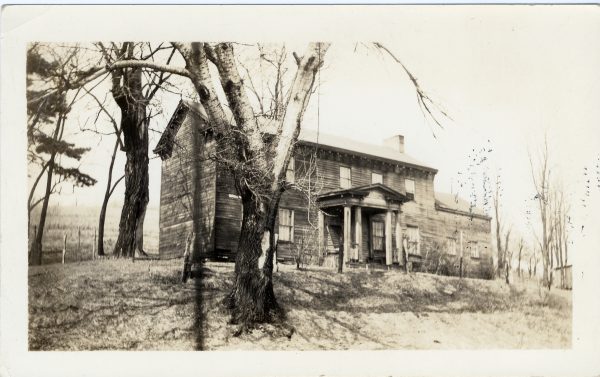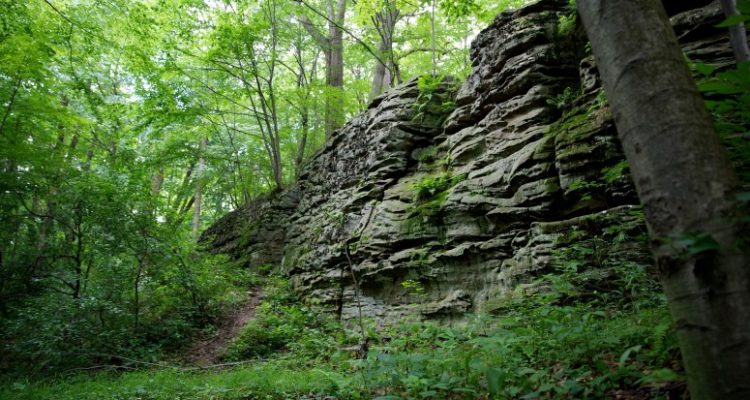After living in a cabin in Wellsburg for a period of time, Sam and Drucilla obtained property in West Liberty, with assistance from Van Swearingon, where they built a large frame house. One of the photos with this story is believed to be of the Brady house in West liberty, which stood on the hill above where West Liberty University is now located on property now owned by the University. While they were still living in Wellsburg, Sam and Dru had three sons. William was born in 1785 followed by Van in 1786 and John in 1790.

Because of his black hair and darkly tanned skin, Sam Brady could easily disguise himself as an Indian. When he was on the trail, he usually dressed as an Indian. During one of his trips back to Fort McIntosh from Wellsburg, Sam noticed an Indian on horseback riding toward him. They were about ten miles from fort McIntosh. Sam was dressed as an Indian and had his gun loaded with his last rifle ball hoping to see some game that he could take home for dinner. As the Indian got closer, he noticed a small white child and a white woman riding behind the Indian. The woman was tethered to the Indian with a rope around her neck which was tied to the Indian’s waist, and the boy was between her and the Indian. Although the woman’s face was badly bruised to the point where her left eye was swollen shut, Brady recognized her as Jenny Stupe who had been taken captive by the Indians, about a month earlier, along with her 6-year-old son. Jenny’s left arm seemed to also be hanging limply by her side.
Brady cocked his gun, calmly rode up beside the Indian, and shot him through the head causing Jenny and the boy to fall off the horse with him. According to most accounts, Jenny thought Sam was another Indian and asked, ”Why did you shoot your brother?” After Sam showed her who he was, he took Jenny and her son to Fort McIntosh with him. Word of the rescue of Jenny Stupes quickly spread throughout the region.
Another Brady exploit of note was the rescue of the family of Albert Gray. Brady was in the company of Benjamin Biggs and Thomas Bevington as they set out from Fort McIntosh headed to Fort Pitt. After some discussion, the trio decided to follow the trail on the Pennsylvania side of the Ohio River. The Virginia side trail was shorter, but it had rained recently, and the trail on the Virginia side was muddier. Another reason for using the Pennsylvania trail was to visit a friend named Albert Gray, who had a home about 10 miles south of Fort McIntosh along a part of the river known as The Narrows. A few miles before reaching the home of the Gray family, there was a river crossing. The three men immediately noticed a large number of tracks in the mud coming up from the crossing. Some were from horses, and some were human. Because of the nature of the tracks, they knew that it was a large Indian raiding party.
The three men left the trail and went around through the open woods until they reached the ridge above the bottom where the Gray home was located. It was a warm, bright, peaceful, sunny day and they could clearly see the gray farm. Beyond the cornfield and garden, they could see a smoldering pile of ashes where the Gray cabin once stood. They moved down the ridge and watched for any sign of movement. Then, Biggs stayed on the ridge with the horses, to serve as a lookout, while Bevington scouted the woods to the left and Brady scouted the woods to the right to see if the Indians had left behind any snipers. Biggs was chosen to stand lookout because of his well-known expertise with the rifle. If he saw any Indians near the farmstead, he would fire a shot to alert the others.
Eventually, Brady had gone about a mile south of the cabin when he heard someone coming. It was Albert Gray who had spent most of the day down at the Ohio River fishing. Brady explained the situation at the farm, the two men joined Biggs and Bevington at the Gray farmstead, where they expected to find the bodies of Mrs. Gray and Albert’s two teenage daughters. Since no trace of them was found, they knew that the girls and Mrs. Gray had been taken captive by the Indians. Bevington informed the others that the raiding party had taken a trail that branched off to the northeast about a quarter of a mile south of the farm. Gray said that he was going to track the Indians and try to do what had to be done to his girls to prevent the Indians from doing to them what he knew that they would do to them. The other three men joined him. From the trail that the Indians had left, it was clear that it was a large raiding party with quite a few horses and a number of people on foot.
Biggs and Brady decided that the Indians would likely take a trail that went to the West a few miles northeast of their location. They expected the Indians to cross the Beaver River several miles north of Fort McIntosh and overnight at a popular camping location where there was a flat sandy spot surrounded by a creek formed by a spring coming out of the hillside. The location had plenty of water and tall grass for the livestock. The men decided to risk taking a shorter route that was more difficult to travel. When they arrived at the location in question, they discovered that they had guessed correctly. The raiding party consisted of 13 Indians. The two Gray daughters were mounted on horses behind two of the Indians to which they were tied with ropes around their necks. Mrs. Gray another white woman and a young boy were on foot. Each was tied to one of the Indians on horseback with a rope around the neck. The Indians made camp on the sandy clearing.
As darkness fell, Brady, Bevington, Biggs, and Gray made plans for keeping the Indians from having the girls. Albert could not bring himself to harm one of his daughters, so Biggs and Bevington agreed be responsible for Gray’s two daughters. Brady would take care of Mrs. Gray, and Albert would take care of the unidentified white woman. Since Biggs was the fastest reloader, he would attempt to get off a second shot to take care of the boy. To us, this plan seems like cold blooded murder, but the brutality of the raiding parties in that region when it came to the rape and torture of their female captives was well documented and the four men were badly outnumbered, so the men took up positions in the tall grass as darkness began to fall. From their firing positions, they watched the Indians and waited for Brady to give the signal. But the Indians did move toward the captives and began to settle down for the night.
When it became clear that the Indians were bedding down for the night, the four men withdrew to the trees, and Brady suggested that they use their knives to try to kill as many Indians as possible while they slept. All four men had been trained to kill by thrusting the knife under the ribcage at a slight downward angle so as to sever the aorta and other major blood vessels under the heart. If done properly, it caused death that is silent and almost instantaneous.
After the Indians were asleep, Biggs slipped over to where the Indians had propped their guns against a large sycamore tree and hid the guns in the tall grass. At Brady’s signal, the killing began. All went well until one of Gray’s victims managed to get to his feet awakening the camp. Bevington put the Indian down with a tomahawk, but the frightened captives ran into the woods followed by one of the Indians with a knife in hand. However, Biggs quickly fired a shot and the Indian fell dead into the creek. Then all was suddenly very quiet. Albert Gray began shouting for his family members telling them that he was there with Ben Biggs and Sam Brady.
After the freed captives returned, they immediately took advantage of the full moon to follow the trail down the Beaver River to Fort McIntosh. Brady rode ahead to alert the sentries at the fort and a group of men quickly mounted and went out to assist the party. The next day, a company of well-armed men rode up to the area of the rescue and counted thirteen dead Indians. They named the area “Bloody Spring.” The stream became known as “Brady’s Run.” The area, where the massacre took place, is located just west of New Brighton, Pa. Today, Brady’s Run Road along the creek leads to a small pond called “Brady’s Run Lake.” The area includes Brady’s Run County Park. (Google Earth GPS Coordinates: 40° 43 58.73 N 80° 20 46.12 W )
On the way back to Fort McIntosh, the men learned that the unidentified woman and her son had been captured by the Indians during a raid on their home in Northern Virginia. Several days later, Brady and some of his rangers took the woman from Virginia and her son back to her home not far from the crossing near the Albert Gray farm. She was reunited with her overjoyed husband, who had assumed that his wife and son were most likely killed by the Indians.




